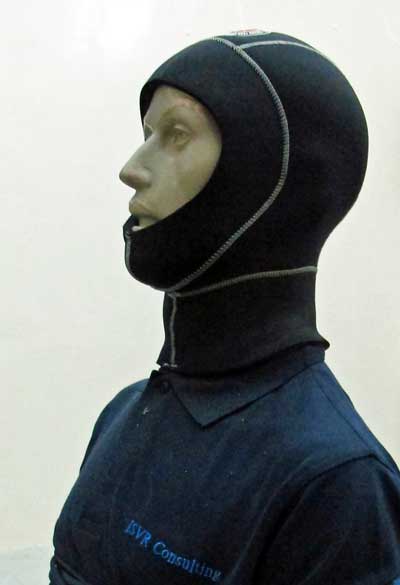Noise exposures from headphones, headsets, telephones and earpieces
Headsets, earphones, telephones and ear inserts are used by many people in the course of their work. Examples include telephonists, air traffic controllers, operators in fire and police control rooms, airline pilots, TV camera crew and floor managers, sound engineers, and telesales operators. It is important that the headphones do not cause daily noise exposures which could exceed the Action Values in the Control of Noise at Work Regulations 2005 ↗ and which, over time, could damage the wearer’s hearing.
There are established criteria for assessing the risk of hearing damage. but these relate to noise from machinery, equipment or loudspeakers rather than from headphones. These criteria are expressed in terms of the noise exposures or sound levels measured in the workplace. Care is taken when measuring these levels to place the measuring equipment, usually a sound level meter, so that the meter operator and anyone else present do not unduly influence the reading by causing reflections or sound shadows. The reading is therefore representative of an ‘undisturbed’ sound field. The Action Values in the Control of Noise At Work Regulations 2005 are for undisturbed sound fields. We can apply these Action Values to headphone use, but not directly.

The Kemar manikin
To measure noise levels from headphones we use a manikin, or artificial head and torso known as ‘Kemar’ (Knowles Electronics Manikin for Acoustic Research). Kemar incorporates microphones to measure sound levels at the eardrum positions. The manikin has been designed to be geometrically and acoustically representative of a median adult human and noise levels measured at the eardrum of Kemar are representative of noise levels which would be present at a median human eardrum under the same conditions. Headphones or earphones can be worn by Kemar and will fit Kemar just as they fit a real person and we can measure the sound levels at the eardrum.
When a person is exposed to noise in a room or factory, their ear canals amplify the noise so that the eardrum sound levels are higher than those in the undisturbed sound field. The amount of amplification varies with frequency. Low-frequency sounds are hardly amplified at all while sounds with a lot of energy around 3 kHz are amplified most, by about 15 dB. The amplification for any particular sound depends on its spectrum, i.e. the amount of sound energy in each frequency region.
We measure the eardrum noise levels and spectrum produced by headphones worn by Kemar. We then subtract out the amplification of the ear canal to determine the spectrum and level of an external, undisturbed sound field which would duplicate the levels produced at the eardrum by the headphones. We can use the noise levels of this notional undisturbed field to calculate daily personal noise exposures for the headphone wearer. These noise exposures can be directly compared with the Action Values of the Control of Noise at Work Regulations. A given noise level and spectrum at the ear drum will give a certain risk of hearing impairment whether that noise level is produced by an external sound field (from machines or loudspeakers) or by headphones.
Examples of measurements using Kemar
We have used Kemar to measure sound levels and noise exposures from headphones in a wide range of situations. These include
- on the flight decks of civil aircraft where flight crew wear headsets (the UK Control of Noise at Work Regulations 2005 apply to aircraft in flight over Britain)
- in call centres or contact centres of building societies, insurance, banking, credit card and telephone companies, and in help and enquiry centres
- in the control rooms and call-handling centres of various police and fire services where operators use headsets to take telephone calls from the public and communicate by radio with officers and vehicles
- in an air traffic control centre
- in a coastguard operations room
- in an independent television studio, where the camera operators wear headsets and where the presenters use concealed ear-inserts to listen to instructions from the programme director
- in the editing rooms and radio studios of a round-the-clock, world-wide, radio service
- in sorting offices of a national postal delivery organisation where staff can listen to radio and music through headphones supplied by the employer, or through their own personal stereos
- at telephone switchboards where operators receive calls from outside
- under fire-fighters’ breathing apparatus which incorporates an earphone for radio communication
- from earpieces used with portable radios (including the new Airwave sets) by police officers on foot patrol, and covert earpieces worn by undercover officers
- from headphones worn by reporters transcribing Parliamentary debates and committee proceedings from recordings
- from headphones worn by reporters to transcribe debates and committee proceedings of the Scottish Parliament while working online from home during the coronavirus pandemic
- from headphones used with PC sound cards by programmers and authors of educational and multimedia CD-ROMs
- from headphones used by telephone engineers tracing copper wire line pairs
- in testing of headphone noise exposure sound limiters for hearing protection
- testing of headphone maximum sound levels for acoustic shock in call centres
- measurement of the maximum sound levels from the headphones of an assistive listening device (ALD) for TV viewers with impaired hearing
- testing of personal music players to EN 50332
As well as general noise exposure assessments, we have provided expert acoustical evidence where hearing damage has allegedly been caused by noise from headphones, headsets, earpieces or telephones, or in claims of acoustic shock.
Other uses of Kemar
Noise sources close to the ear
Headphones fit over, on or in the ear, but the measurement techniques are equally applicable to noise sources which may be held close to the ear, for example, children’s toys. We have used Kemar to measure the sound from children’s toys for a toy manufacturer and distributor. In addition, the manikin technique has proved useful in measuring noise from power tools such as electric drills or grinders which are sometimes held very close to the head.
Insertion losses of hoods
We have also used Kemar to measure the insertion losses in air of wet and dry neoprene diving hoods of various thicknesses from 2 mm to 9 mm. Insertion losses may be used to calculate noise levels at the ear when the ambient noise level and spectrum outside the hood is known. The exposure of divers to high levels of noise is recognised and included in the HSE’s Approved Codes of Practice and guidance, L103 (Second edition) Commercial diving projects offshore. Diving at Work Regulations 1997 ↗ and L104 (Second edition) Commercial diving projects inland/inshore Diving at Work Regulations 1997 ↗. Both of these publications state that “Divers are exposed to a range of noise sources, both on the surface and underwater. These levels may be significant and diving contractors should ensure that the risks are managed”.

Diving hood on Kemar
Relevant publications
For further details see:
- M C Lower, 1992: Headphones and the Noise at Work Regulations. Health and Safety at Work, p.33, April 1992.
- M C Lower and M Bagshaw, 1996; Noise levels and communications on the flight decks of civil aircraft. 349 – 352, Proceedings of Internoise 96 (Prof. Bagshaw was formerly Head of Occupational and Aviation Medicine at British Airways, and is now the Director of Aviation Medicine at King’s College London and Visiting Professor at Cranfield University).
- M Bagshaw and M C Lower, 2002; Hearing loss on the flight deck – origin and remedy. ↗ The Aeronautical Journal, 106(1059), 277-289. (Abstract available to all, full paper available to registered visitors to the publisher’s website.)
- G S Paddan and M C Lower, 2021; The effect of wearing an anti-flash hood on the noise attenuation of earmuffs. Gurmail Paddan, Institute of Naval Medicine and Michael Lower, ISVR Consulting. Industrial Health, 59(4), 204 – 219. (Open access under CC-BY-NC-ND 4.0 ↗).
- G S Paddan and M C Lower 2021; Attenuation of airborne noise by wet and dry neoprene diving hoods. Underwater Technology 38(1), 3-12, doi:10.3723/ut.38.003.

